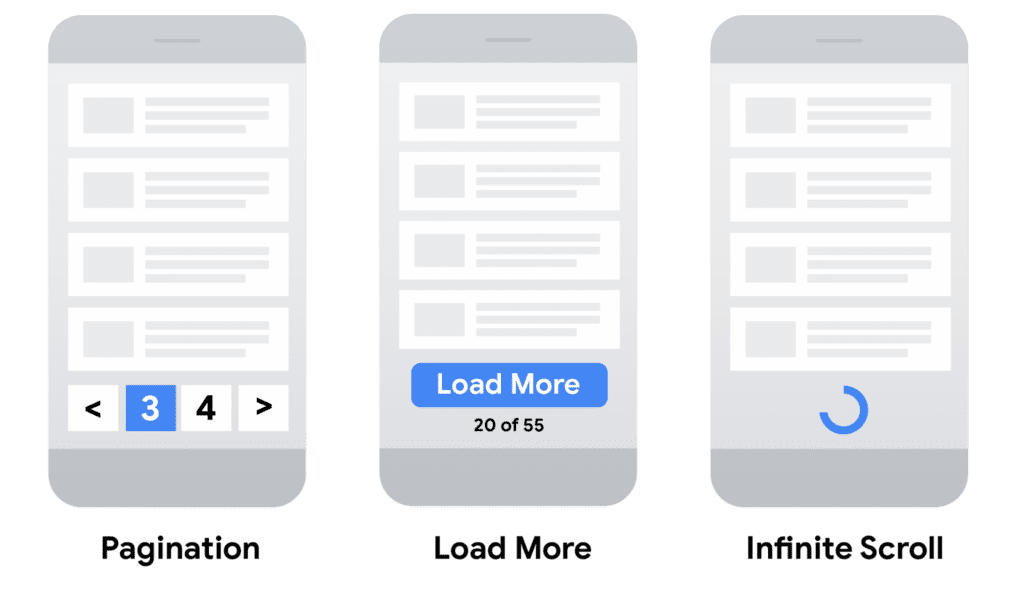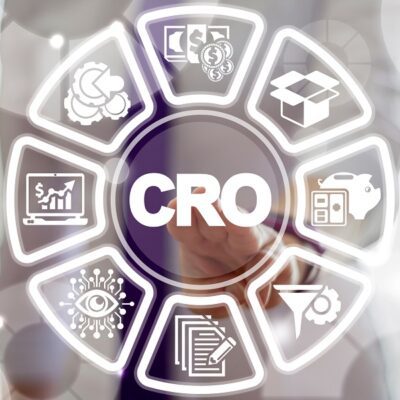With the coronavirus pandemic pushing more and more people online to research products, businesses no longer have to worry about just ranking near them if they have an e-commerce arm. They now need to reach out and potentially connect with customers from all over the world. The biggest challenge with any e-commerce site is just being discovered. But once a customer has confidence in an e-commerce store, they’re much more likely to shop there over and over.
Google has published a rare look behind the curtain and listed best practices for e-commerce sites to rank on their platform. And this article will go over how you can do that for your business website.
Where e-commerce content can appear on Google
It’s important to realize the true full scope of reach your content can get online. Google has so many features beyond just the basic SERPs. That includes the main search results, Maps, Google My Business, the shopping tab, and more. Providing the correct information on the right Google surface will assist you in reaching out to new customers.
Google Search
When you have this for an eCommerce site, that means each page and product needs to have structured data and keywords in order to rank. Having an eCommerce site means you could potentially rank on a national and international level depending on your product. So make sure you know how SEO works to maximize your reach.
Small changes to portions of your website may appear minor when seen separately. But when combined with other optimizations, they can have a significant influence on your site’s user experience and performance in organic search results. Plus you should always be working on your SEO in order to improve the reach of your website and potentially increase traffic and customers.
You should build a website to benefit your users and gear any optimization to improve the user experience. You probably don’t think about it this way, but Google is a user of your website. It wants a good experience so that it can show that experience to other people searching for your keywords and content. SEO is really about helping search engines understand and present content. Also, Google employs structured data to decipher the page’s content. You can assist them by providing particular information about your site, which will allow your site to appear in search results with more features.
Google Images
Google Images is a visual search engine that allows you to find information on the internet. Users can quickly explore content with greater context surrounding photos with new features like picture descriptions, prominent badges, and AMP results. Results can become much more relevant by providing more context to images, leading to higher-quality traffic to your site. Make sure your photographs of every product on your website are optimized for Google Images to help with the discovery process.
Google Lens
Ensure your product data are uploaded to Google Merchant Center, opt in to free product listings, and follow the Google Image best practices if you want your products to appear in Google Lens search results. You must first construct a feed to which you may send your product data before publishing it to Google Merchant Center. This step is required for any new feed, and once a feed has been registered, you can update it without re-registering it. This can be an incredibly important way to reach new customers just generally searching for the types of products you offer, and it’s a stepping stone into more visible search results like the Google Shopping tab.
Google Shopping Tab
Once you upload your products to Google Merchant Center, they can also appear in the Google Shopping tab as paid or free experiences. Millions of consumers use Google Merchant Center to find, explore, and buy your products. Thanks to its feature set and extensive reporting capabilities, it provides various options for getting the appropriate products to the right client. This is a crucial step if you have an eCommerce site and want to reach more people.
Google My Business
Google My Business is one of the best ways to turn people who find you on Google Search and Maps into new customers. It also improves your visibility and increases your website’s SEO opportunities.
Create a free Business Profile for your storefront or service area to start diving deeper into all the potential listings you can add your business into. It won’t take a lot of your time but will potentially increase leads to your page as users looking for services in listings have a high conversion rate.
Google Maps
Upload your products to Google Merchant Center with inventory location data to make them available in Google Maps search results. Start by creating a local products inventory feed for local inventory ads and free local product listings. The local products inventory feed contains a list of the items you sell in each location. Some characteristics are required for all items, while others are only required for particular categories of things.
Share your product data with Google
Once you’ve taken advantage of all the available options and maximized the scope of your eCommerce site, you want to share your eCommerce product data with Google to boost your eligibility for richer appearances and on more surfaces throughout Google. Ultimately this step delivers more relevant visitors to your site. To take advantage of it, Google suggests incorporating structured data onto your product pages and submitting a feed to Google Merchant Center.
Some of the benefits of uploading feed files to the Merchant Center include:
- Increase confidence that all of your products are known to Google. Web crawling is not guaranteed to find all products on your site.
- Gain more control over when updates are delivered. Google does not guarantee how long it takes before changes on your site will be processed through crawling. Feeds can be used for weekly, daily, or even hourly updates, at your time of choice. The Content API allows immediate content updates, which is particularly useful for stock level updates.
- Share information that isn’t available on your website. You may decide that some information, such as inventory data at the physical shop level, should not be included on your website. You can communicate this data with Google using feeds and the Content API without it being visible on your website.
Include structured data relevant to e-commerce
Google crawls and indexes your eCommerce website in the same way it crawls and indexes other websites, using algorithms to decipher your content and intent. Structured data is a machine-readable format for storing information about a web page. It will also help Google understand your content more accurately.
Although some structured data types are exclusive to eCommerce, structured data, in general, is not. The resources listed below can help you learn more about structured data.
- Understand how structured data works for an introduction to how Google uses structured data.
- See schema.org to get a sense of the scope of structured data. Many of its defined forms of structured data are supported by Google.
How to launch a new e-commerce website
Maybe you’re just starting out in the eCommerce world. You want to set yourself up for success. To make sure Google can find your new commerce site at launch, we recommend doing the following to register your new site with Google:
- Verify your site ownership. This is the process of proving that you hold the property you claim to own. Because verified owners have access to sensitive Google Search data for a site and can affect a site’s presence and behavior, Search Console needs to verify ownership. A verified owner can grant full or view access to other people.
- Ask Google to index your site. You can ask Google to re-index a page on your site if you’ve just updated or changed something on it. You cannot, however, request indexing for URLs that you do not control. When you’re just starting out, you can submit just a handful of URLs for inspection. But if you’re ready to submit the whole site, you want to use an HTML sitemap.
- Track how Google Search indexes your site. Google Merchant Center may verify and cross-check content with the Google Search index. To avoid false verification warnings, ensure that your site is indexed in Google Search and products are available for purchase. You can use the Index Coverage report to check the progress of indexing.
- If you also have a physical location for your store, establish your business details with Google. By first registering your official website with Google, you can improve its visibility and coverage in search results. Users will be able to recognize your official site and find the information you provide more quickly when searching.
- Sign up for Google Merchant Center to provide additional information such as descriptions of your products and deals.
Designing a new URL structure for eCommerce sites
This goes hand in hand with building your site if you’re just starting out with an eCommerce arm of your business. When you design your URLs with SEO in mind, it helps to avoid indexing issues down the line. Bottomline, well designed URLs are easy to track and help search engines to more easily crawl and find your content.
With that in mind, keep these factors in mind:
- Avoid URLs for different products that are too similar. Google will consider these the same URL. Things like /tshirt#white and /tshirt#black will be indexed as the same URL. Google calls these fragment identifiers and they should be avoided.
- Avoid different URLs that ultimately lead back to the same web page. Google will read these as duplicate content and ultimately penalize the page or take longer to return the right results.
- Avoid timestamps in your URLs. This could appear to Google like you have an infinite number of pages.
- Convert all text to the same case so it’s easier for Google to determine if URLs reference the same or different pages.
- Make sure each page in your paginated results has a unique URL.
- Add in very descriptive words. So instead of just /tshirt-white, it helps people and Google understand what is on the page. For example, /tshirt-white-small-blue-flower-pattern
A common problem for URL and eCommerce sites is what is known as product variants. For example, a tshirt that has multiple colors and patterns will each have a unique URL. It is possible to include multiple variants in one page. But that does give you restrictions when it comes to Google shopping that can only show one variant in the results rather than multiple options. To decide the best one to show you need to use a canonical URL.
Help Google understand your e-commerce site structure
Now that you have the URLs set up, you have your structured data in place, you’ve launched your online business, you’re ready to make sure that Google can understand the structure of it and index all pages. Now you need to show the most important pages on your site and show the link structure.
This starts with making sure the navigation is Google Crawler friendly. This goes back to structured data. It means you add links from menus to category pages. Then from category pages to subcategories. And then from there to all your product pages. This kind of site structure is very easy to crawl and follow for the Google algorithm.
Promote your best categories or products
Google will look at the URLs of your product page to index and return results. But it doesn’t tend to look at URL structure to understand the site. So if you have sub-URLs or breadcrumb-like structure built into the URL, it won’t matter as much. Instead, to determine a page’s importance, Google looks at an SEO classic, links. The higher the importance of the page, the more links it will have to it within a site. So for a top performing product, you might want to list that on your homepage.
Pagination, incremental page loading, and their impact on Google Search
Your final step to improve your eCommerce site in the eyes of Google is to maximize the page experience. Page experience is a key Google ranking factor and matters no matter what kind of website you have.
In this guide, Google specifically mentions incremental loading content. This includes things like search results for a particular product that might not include every single item in a subcategory. Or things like blog comments, user reviews, or posts related to a search. Incrementally loading content helps to improve the page experience because it helps the page load faster. It also reduces network traffic, which is better for mobile browsers.
What UX is right for my website?
To adapt to the incremental load, you have a few different options in how to display your data. That includes:
- Pagination – where a user clicks next page or previous page, or even a page number in order to view results.
- Load more option that extend the initial set of results.
- Infinite Scroll – This is helpful when a user reaches the bottom of your initial list of results, then the page automatically loads the next set of content.

All three of these options have their own pros and cons. It honestly depends on your site, the kind of content, and the experience you want to provide for your users. Google will index each of them differently, but that doesn’t necessarily mean one is better than the others. But whichever method you choose, you want to make sure Google can still find the content.
- Link pages sequentially
- Use the URLs correctly
- Avoid indexing URLs with filters or sort orders
Get My E-commerce website ranking
We’ve gone through a lot in this blog. It’s a rare look behind the curtain from Google to really line out best practices. We hope the examples provided here can help you get your eCommerce site ranking and provides you with some best practices to get you started.
But if you need help, we can help! Boostability specializes in SEO and can help get your site ranking. That includes everything from structured data to site structure, and help getting your eCommerce site submitted in the right places so that you can attract customers locally and really all over the world if they’re interested in your products.
Ready to get started? Try our free website analysis tool to see where your website stands and get in contact with us today! The sooner you start ranking, the sooner you can reach new customers!










